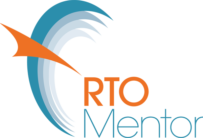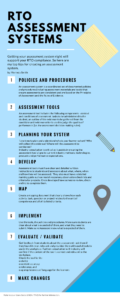RTO assessment systems are incremental in your business.
There should be a method in your madness when developing them. Start with the end, the outcome. Then as you develop them you include more to guide others. Consider the student, the length of the course and any other factors that need to be considered for your learners. When collecting assessment evidence is isn’t just to show the end result.
Setting up your assessment system
So often when working with organisations I find that the assessment system is in need of improvement. OK, I get that life gets in the way and people get busy (yay!). That’s great news that you are busy. We also need to think about the student and the RTO assessment systems that were put in place. This is an area that constantly shows up and why people don’t pass their audits. So it is very important that RTOs get it right.
Lets go back to the beginning. We commence the planning of delivery and assessment of our qualifications or training product. We have commenced writing the training and assessment strategies, planned the trainers and assessors and when validation is going to take place. This tells us the big picture. Now we need to drill down and create assessment tools and instruments for our units, providing the detail.
When choosing your assessment methods for particular unit/s of competency, you need to use your unit of competency as your guide.
Often we need to develop a series of tools that support the way we are going to undertake the assessment.
Consider ways of gathering the evidence.
Firstly what are the student needs? Do they have any special need that will influence the way the assessment are done? Do you need to observe the person doing the task? Or will that take far too long, and perhaps you need to review the finished product.
Consider the students you are working with and make sure the evidence you plan on getting them obtain are viable. For instance are we asking them to refer to their workplace documents and policies, and yet the students are not in a workplace?
Observation checklists are a very powerful way of showing evidence collection. Whoever if we are assessing multiple students, then you need to consider the best way to collect the information.
Evidence compiled by the candidate. Will you be asking the student to present or collect Portfolios, Collections of work samples, a product with supporting documentation, Journal/log books or Information about life experience?
Are there any assessment conditions that impact on the collection?
Who is needed to collect the evidence? Can we use a workplace supervisor, another assessor. You need to consider these things, so you can make sure that they competent to do so, and have been well-informed. The Training Package Assessment Guidelines may provide assistance with who can collect evidence. It is important, whether it is the candidate, the assessor or a third-party evidence gatherer, that the instrument and instructions of your assessment tools clarify what is expected, and provide a clear structure for them to follow.
Where will the evidence be gathered?
The workplace is one of the best places of collecting evidence. However this is not always feasible. Your alternative is to select settings and methods that enable the candidate to demonstrate their competence to the level of performance specified. Simulation is a form of evidence gathering that involves the candidate in completing or dealing with a task, activity or problem in an off-the-job situation that replicates the workplace context.
When will it be gathered?
How are you going to collect the knowledge evidence?
Develop tools that consider the literacy and numeracy skills and language proficiency of our students. This might be influenced by the skill levels that are required in the qualification. If you are in any doubt, you may need to draw on the expertise of specialist Language Literacy and Numeracy (LLN) professionals to make this judgement.
We need to see the students are able to consistently perform the tasks, against the standards, with the necessary underpinning knowledge.
Ensure you provide reliable and fair tools, which includes instructions for our assessors and students, in the task they are to perform or undertake. The instructions are very important to make sure each assessor knows what is to be performed. This also includes any reasonable adjustments that may be made, or the information you are allowed to tell the students. The reasonable adjustment is not about making it easier, it allowing a different way of the student demonstrating their competence – that they can still do the task.
Is every item that is going to be collected needed as far as the unit is concerned?
Your mapping document is a guide for you to know that the whole unit has been covered. When developing your mapping document, remember to drill down to each question, or point within tasks, so you can really see what is happening within your assessment. this also enable you to refine the tools following validation activities, and ensure the integrity of the tool remains.
Provide a marking guide that gives rigour to assessors when making assessment judgements. Provide dot points or criteria of what the expected responses are likely to be. If you have a portfolio in the evidence then show what needs to be collected by the student to meet the requirements as laid out in the unit. This could be a checklist. If reviewing a completed object develop a checklist that provides criteria of what the assessor is looking for.
Then there is a recording document that allows the assessors to collect all the evidence and make sure they have everything that was mapped to the unit.
Then of course you need to validate your whole system to ensure that what you have planned is actually working. Update your validation plan.
Finally review your Assessment policies and procedures to make sure everything you have developed fits within your own RTO assessment system.

